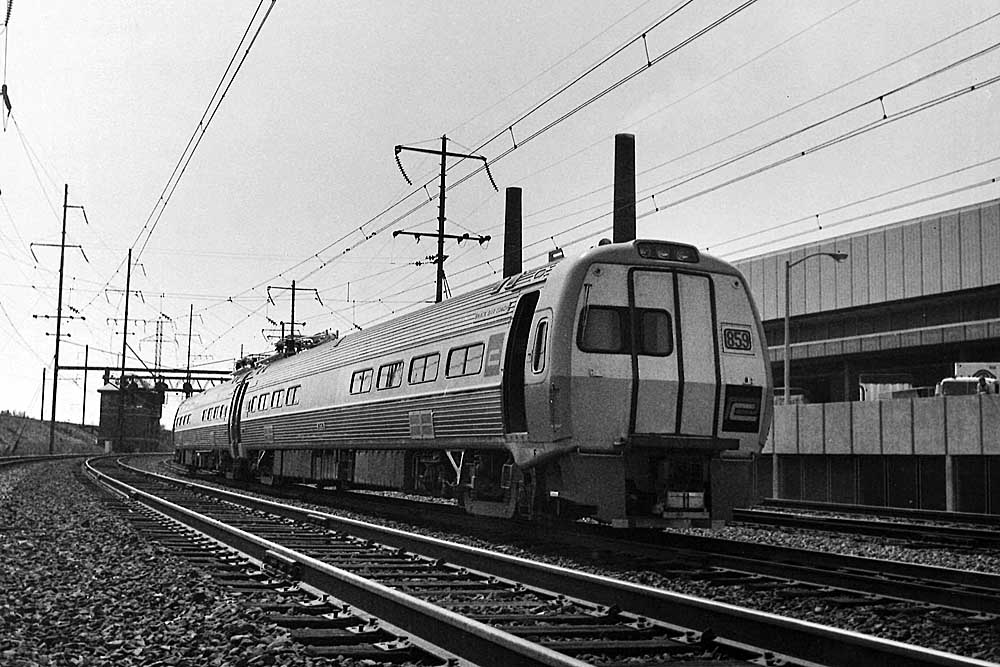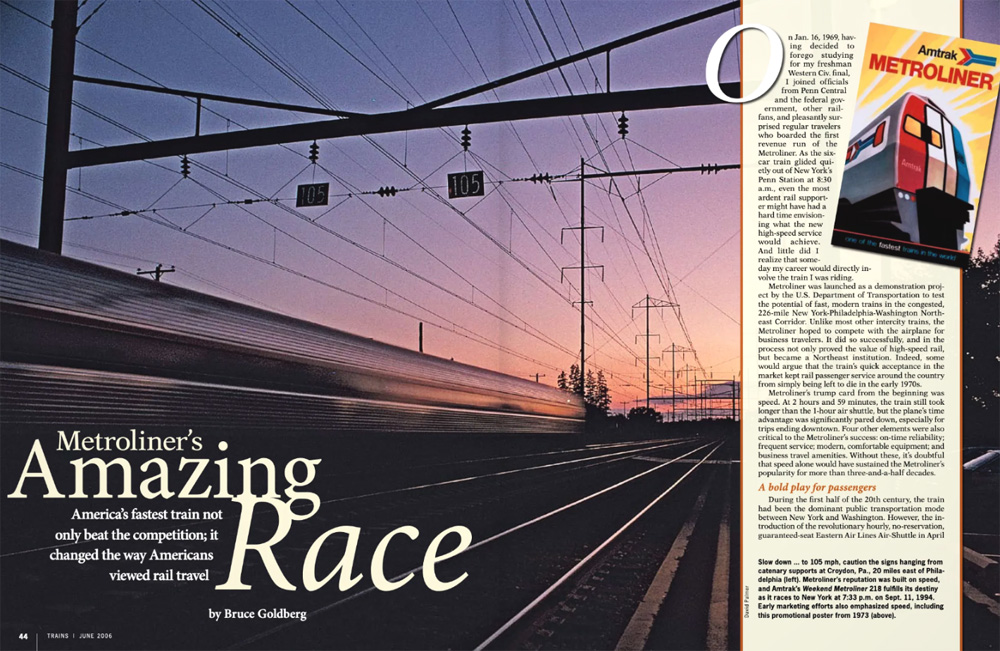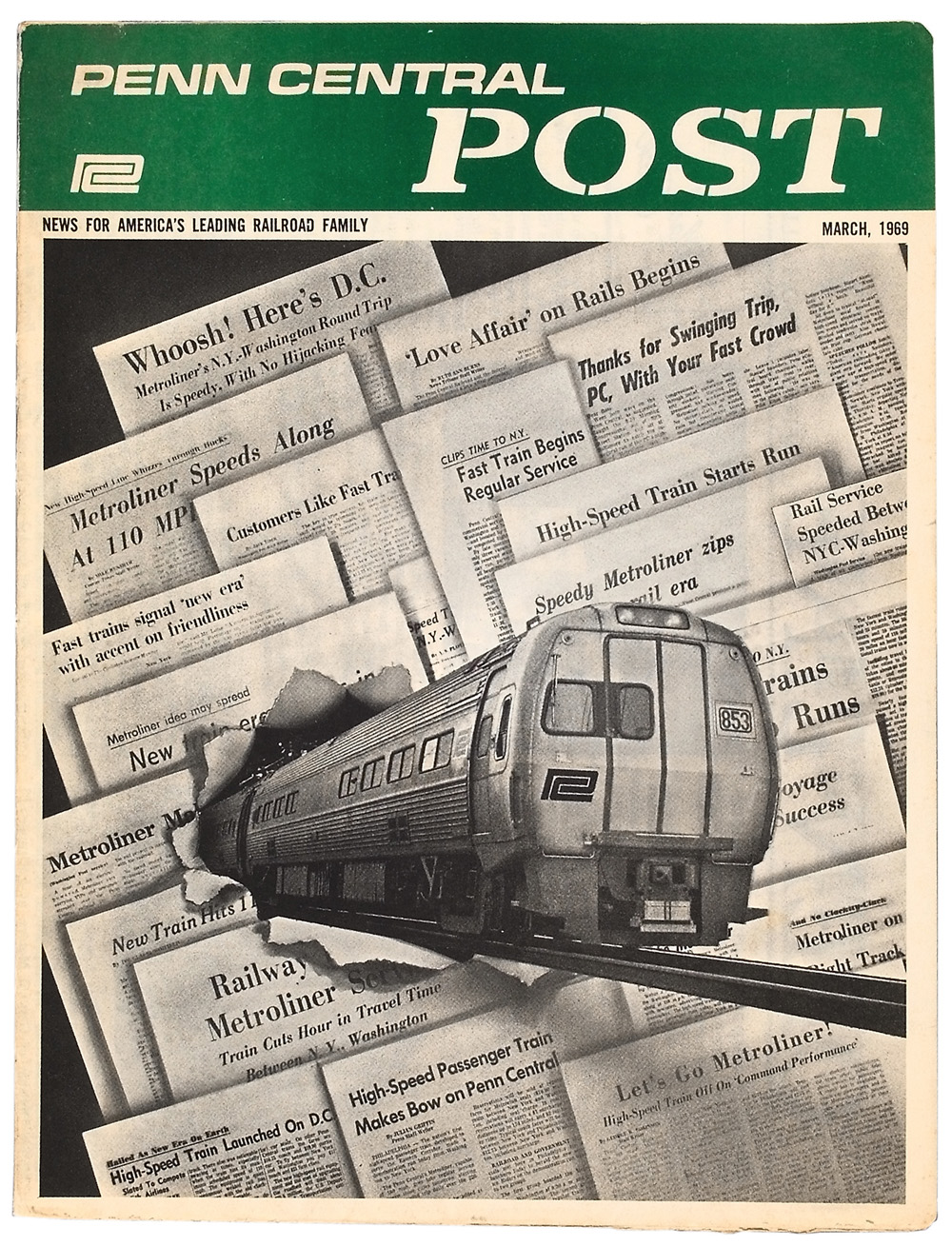
The Metroliner leapt out of the starting gate in January 1969, beat the airline competition, and became a way of life for rail travelers throughout the Northeast.

In the June 2006 issue of Trains Magazine, author Bruce Goldberg examines Metroliner’s distinguished career, from its launch by Penn Central to its stewardship under Amtrak, which nurtured the high-speed service into a renowned brand of travel between New York and Washington by beating the airlines at their own game.
The train name may soon be retired, but the train’s legacy will live on as long as business travelers opt for the train over competing travel modes.

While employed with Amtrak, Goldberg was present for many of Metroliner’s setbacks and triumphs over its 37-year run, and he developed this timeline of pivotal Metroliner moments as a complement to his article in Trains Magazine:
- September 30, 1965
High Speed Ground Transportation Act signed into law establishing a high-speed rail Northeast Corridor Demonstration Project. - October 29, 1967
Running time for the Pennsylvania Railroad’s New York-Washington Afternoon Congressional is reduced to 3 hours, 20 minutes, capitalizing on infrastructure improvements being made in preparation for the start of Metroliner service. Faster schedule lasts 6 months. - January 15, 1969
Metroliner is introduced with a media run from Washington to New York. - January 16, 1969
Penn Central Metroliner begins revenue service, with one daily round trip leaving New York in the morning and returning late afternoon from Washington. - February 10, 1969
A second Metroliner round trip is added, leaving Washington in the morning. - April 2, 1969
Nonstop 2-hour, 30-minute round trip begins, departing New York at 7:10 a.m. and leaving Washington at 4:30 p.m. - January 24, 1970
President Nixon travels on a Metroliner special from Washington to Philadelphia for the 7th Anniversary of the Philadelphia Orchestra. - October 26, 1970
Service expands to 6 weekday round trips. Nonstop round trip adjusted to operate in the morning from Washington and Baltimore to New York. Expanded service officially begins the “Northeast Corridor Demonstration Project.” - May 1, 1971
Amtrak takes over the nation’s intercity trains and marks the occasion with a special ceremonial Metroliner trip from Washington to New York. Metroliner schedules increase to 9 weekday round trips. - November 14, 1971
Service expands to 12 hourly round trips, and one round trip extended to New Haven. - May 1, 1972
Service expands to 14 weekday round trips. - October 28, 1973
Service increases to 15 hourly round trips. - February 15, 1976
Two evening round trips discontinued as Metroliner M.U. equipment refurbishing program begins. Weekday round trips fall to 13. - Summer 1976
Amtrak tests leased Swedish and French electric locomotives pulling Amfleet cars on some Metroliner runs. - October 30, 1977
New Haven Metroliner service discontinued owing to federal funding cutbacks to Amtrak. - November 20, 1977
New Haven Metroliner reinstated. - February 22, 1978
New Haven Metroliner again discontinued, this time owing to a change in the electrical system north of New York. - April 30, 1978
Metroliner schedules lengthened to 3 hours, 20 minutes as Northeast Corridor Improvement Project (NECIP) work begins. With Amfleet cars in use on some Metroliner runs during the M.U. refurbishment program, the trains are now identified as “Metroliner Service” in Amtrak timetables. - April 29, 1979
Schedules lengthened again to 3 hours, 30 minutes owing to NECIP work. - April 27, 1980
Schedules lengthened to about 3 hours, 45 minutes, with a few midday Metroliners taking almost 4 hours. - Early 1981
On-board phones discontinued after federal government recalls radio frequencies. - April, 26, 1981
Metroliner Service schedules reduced to 3 hours, 29 minutes. - October 26, 1981
Three weekday Express Metroliners, stopping only at Baltimore and Philadelphia, restore 2-hour, 59-minute schedule between Washington and New York. Three midday trips are dropped, reducing service to 10 weekday round trips. New Haven Metroliner restored. - Early 1982
Original Metroliner equipment withdrawn. All Metroliners are now Amfleet equipped. - February 7,1982
Wilmington stop added to Express Metroliners. Dinettes added to Express Metroliners, and to all Metroliners by spring. - October 31, 1982
Express Metroliner running time reduced to 2 hours, 49 minutes, and remaining Metroliners all scheduled for under 3 hours, for the first time in several years. Two New England Metroliner round trips introduced between New York and Boston. - April 28, 1984
New England Metroliner makes last round trips. - April 29, 1984
San Diego-Los Angeles Metroliner introduced, making one daily round trip. - April 28, 1985
San Diego Metroliner discontinued. One midday New York-Washington round trip restored. - October 26, 1987
Morning nonstop Metroliner Express from Washington and New Carrollton introduced, making trip to New York in 2 hours, 40 minutes. - October 29, 1989
Downingtown, Pa., to Washington morning Metroliner begins. More nonstop Expresses added, increasing service to morning and afternoon weekday departures in both directions. - April 2, 1990
Nonstop express running time reduced to 2 hours, 35 minutes. - October 29, 1990
Morning nonstop expresses scheduled for 2 hours, 30 minutes. This schedule would last only 6 months. - October 25, 1991
Downingtown-Washington Metroliner makes final trip. - February 1, 1993
Swedish X2000 trainset begins 3 months of testing on Metroliner schedules. - October 5, 1993
German InterCity Express trainset begins 2-month Metroliner test. - December 11, 2000
First Acela Express trainsets put into revenue service. - April 29, 2001
Acela Express begins to replace Metroliner frequencies. - April 29, 2002
Only 4 weekday Metroliner round trips remain. - August 2002
A full schedule of New York-Washington Metroliners is reinstated, after the Acela Express is “grounded” for cracks in a yaw damper bracket. - October 2002
Acela Express trainsets begin returning to service. - November 1, 2004
Metroliner Service drops to two weekday round trips. - April 15, 2005
Only 10 days before Metroliner is scheduled to be retired, Acela Express trainsets are again withdrawn from service, this time owing to cracks in the brake rotors. - April 25, 2005
Metroliners replace most Acela Express schedules. A week later, a full schedule of Metroliners is restored, including 4 running through to Boston. - October 31, 2005
With Acela Express trainsets returned to service, only one weekday round trip Metroliner remains. - October 27, 2006
Metroliner’s 38-year run comes to an end. Train 2300 departing Washington at 10:00 a.m. for New York, and train 2301 departing New York at 6:00 p.m. are the final runs. Train 2301 arrives Washington Union Station at 9:30 p.m., 31 minutes late, with the last 140 Metroliner passengers. The consist of the final trip is AEM-7 903 (train 2300 only), AEM-7 947, business class coaches 44724 and 44706, dinette 43361, business class coaches 44708 and 21792 (Quiet Car), and Club-dinette 48182 (first class).














I road the original Metroliner MU cars several times bstween Philadelphia and Washington DC. I was always impressed by their speed and comfort. On one evening ride from Washington DC. I road in the original parlor car configuration and enjoyed a nice meal as well. I do miss the old MU type of cars and the old parlor car configuration of the first class service.